An important aspect of a child’s communication development is the ability to engage in the back-and-forth exchange of information that occurs during a conversation. It’s an essential skill for children to develop, as it allows them to participate in social interactions, and effectively communicate their needs, thoughts, feelings, and ideas.
This article helps to explain what conversational speech is, when it can be expected in typical language development, and why it is an important skill for children to acquire.
What is conversational speech?
Conversational speech involves taking turns speaking and listening during a conversation amongst two or more individuals. It involves the use of verbal (speaking) and nonverbal cues to show interest and understanding, such as eye contact and nodding. It also involves the use of appropriate language and communication skills, such as using appropriate words and sentence structure, all while following social norms and expectations based on the location and situation.
Why is Conversational Speech important for children?
Some children may struggle with conversational speech for a variety of reasons. They may have difficulty with language, such as understanding and using words and sentences, or difficulty using nonverbal cues. They may also have difficulty with social skills, like initiating and maintaining conversations, or understanding what is expected of them in any given social exchange.
Developing conversational speech skills benefits children in a number of ways. It can improve their communication with others, allowing them to express their needs and wants more effectively. It can also improve their social skills, helping them to make and maintain friendships and participate in social activities. Finally, it can improve their overall quality of life, as it allows children to better communicate with people and feel more included and connected to the world around them.

When does a child start to have conversations?
Children begin to understand that one person typically speaks at a time from the time they are infants. This is learned through interactions with the baby and by the baby observing conversations happening around them. By the time a child is around 2-3 years old, a young child begins to answer and ask simple questions which is the basis of conversational speech. This is around the time you can start to expect the first true back and forth conversation to appear. As a child develops cognitively, gradually more comments and questions will be added until a topic can be maintained for a short time.
How can you help your child develop conversational speech skills?
There are several ways you can encourage your child to build and improve upon their conversational speech skills. Here are a few simple strategies you can think about when engaging with your child:
Be a good speaking model: It can be all too easy to go about your day without saying much. From time to time, try sharing your thoughts and observations aloud with your child: “Wow, it’s raining really hard right now. We’re going to need our umbrellas on our walk!” This will help them to learn the connection between what you are thinking and what you decide to say out loud. Next time it’s raining, your child may also be thinking about umbrellas, so you could ask: “What do you think we’ll need when we go outside?”
Keep the conversation going: Try to expand on a spontaneous remark by making a comment and asking a question to keep the conversation going: “I want to eat pizza.” (“Me too, let’s have it for dinner tonight. What kind of pizza do you want to have?”)
Be attentive and encouraging: When your child is speaking, show that you are interested and engaged in what they have to say by looking at them and waiting for them to finish speaking. After they have finished speaking, offer an encouraging comment or answer their question in a positive way.
You can also try incorporating conversational speech teaching into activities you do on a daily basis, such as:
Reading:
Instead of reading every page in a book to your child, take a conversation break to get them actively participating. Talk about the pictures you see on the page. For example, when reading The Very Hungry Caterpillar by Eric Carle you can ask your child:

Have you ever seen a caterpillar? (Yes!!)
Oh, you have? Where did you see it? (Outside!).
Wow, that’s really cool. What colour was it? (Green!).
This exchange helps the child with listening and information sharing in the context of a quick back and forth conversation. Taking a break to talk about the book will encourage your child to think more about what they see on the page, and inspire more conversation in the pages to come.
This is not the end of the conversation!
Conversational speech is an important aspect of communication for all children. By using the strategies above, you can help your child improve their conversational speech skills to better communicate with the people around them.
If you have questions about conversational speech or have concerns about your child’s speech and language development, ask us a question or book a free phone consultation with a Speech-Language Pathologist.

